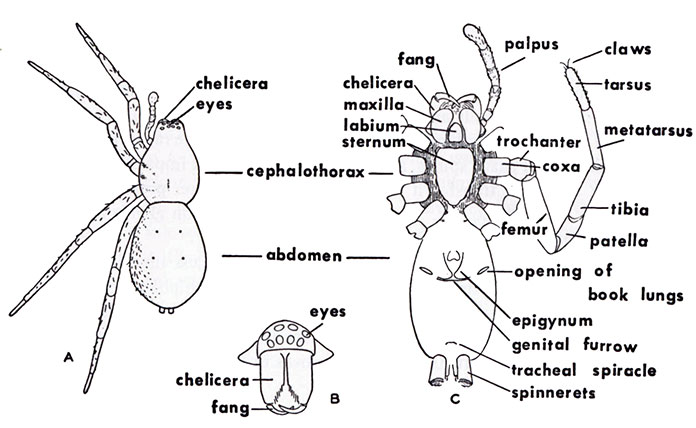Golden Crab Spider – Misumenoides species
This golden crab spider has captured a Painted Lady Butterfly. Crab spiders (often called flower spiders) are known for their oversized front legs and resemblance to the familiar crustacean seafood item. The term flower spider comes from their habit of lying in wait on flowers, much like the assassin bug or numerous other opportunistic predators.
Other species in Thomisidae have brightly colored camouflage which makes them nearly invisible when lying in wait on or near flowers, where they snag unwary insects blundering withing range while nectaring. Their prey includes butterflies, flies, beetles, and bugs.
Like all spiders, crab spiders go through a simple metamorphosis. Young crab spiders hatch from eggs and look like tiny adults. They shed their skin as they grow. Most live for less than 1 year. Females produce hundreds of eggs in the fall, and the offspring hatch in the spring.
 External Spider Anatomy
External Spider Anatomy
A. Dorsal (top) view B. Front view of face and chelicerae C. Ventral (bottom) view (some legs omitted) [1]
Spiders, like most other arachnids, have their body divided into two portions, the cephalothorax and the abdomen. The cephalothorax consists of the head and thorax fused together. Most spiders have four pairs of legs attached here, activated by muscles inside the chitinous exoskeleton. The top of the cephalothorax is covered by a convex hardened shield (carapace), with the eyes mounted at the front.
The eyes are simple, and resemble the ocelli of insects. Most spiders have 8 eyes; Some lineages have lost some or all their eyes, ergo there are spiders with 8,6,4,2, or one or none. The size and positions of the eyes is widely variable. Many of the hunting spiders, e.g. Salticidae (jumping spiders) and Lycosidae (wolf spiders) have large, forward-facing eyes and keen vision required for their craft; many of these spiders have at the back of the eye a reflective membrane called a tapetum [1]. It is this surface that aids in night vision and causes their eyes to reflect light and shine in the dark, like a cat’s eyes. Most sedentary spiders have relied on their sense of touch for so long their vision is thought to be poor [3].
Spider eye arrangements are a simple diagnostic tool that can often get you to the family level. There is a great reference at Bugguide.net showing templates for many different families [2].
References
- William J. Gertsch, PhD. “American Spiders“
- Lynette Schimming, Bugguide.net, “Spider Eye Arrangements“
- Misdiagnosis of Spider Bites: Bacterial Associates, Mechanical Pathogen Transfer, and Hemolytic Potential of Venom from the Hobo Spider, Tegenaria agrestis (Araneae: Agelenidae)
Melissa M. Gaver-Wainwright, Richard S. Zack, Matthew J. Foradori, and Laura Corley Lavine
Journal of Medical Entomology 2011 48 (2), 382-388
Spiders Index | Spiders Main | Beetles | Butterflies | Stinging Insects
